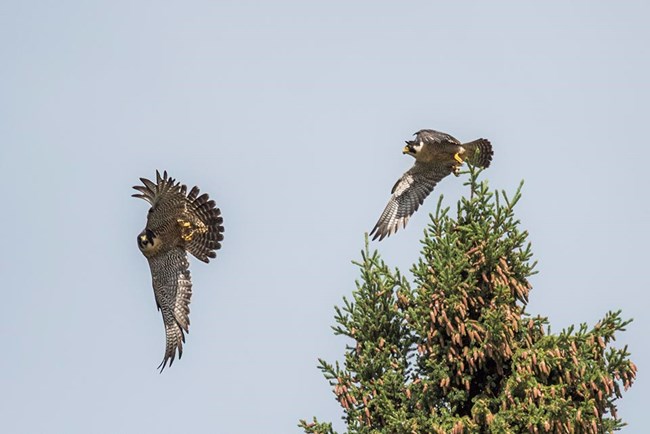Last updated: November 3, 2022
Article
Peregrine Falcon Recovery

NPS/Sean Tevebaugh
Recovery of American peregrine falcons along the upper Yukon River, Alaska
Abstract
American peregrine falcons (Falco peregrinus anatum) throughout North America declined following the introduction of dichlorodiphenyltrichloroethane (DDT) in 1947. In the 1960s, intensive studies were initiated in many areas of North America, including interior Alaska, to determine the cause of the decline and assess population status. From 1977 to 2015, we studied peregrine falcons along a 265‐km section of the upper Yukon River in east‐central Alaska. We counted occupied territories, documented breeding success and productivity, and collected unhatched eggs for contaminant analysis. We observed 1,602 occupied territories and 2,349 nestlings. Annual breeding success averaged 64%, and annual productivity averaged 1.54 nestlings/territory and 2.38 nestlings/successful territory. Annual rates of increase in the number of occupied territories were greatest in the late 1970s and 1980s (8.6%), moderate in the 1990s (2.8%), and least in the 2000s (1.5%). Reproductive metrics were highest in the late 1970s and 1980s, declining in recent years. As the number of occupied territories increased (14–60) and average nearest neighbor distance decreased (from 9.8 km to 2.6 km), breeding success declined (from 71% in the 1980s to 57% in the 2000s). Productivity, as measured by nestlings per occupied territory, declined (from 1.84 in the 1980s to 1.29 in the 2000s). Nestlings per successful territory also declined from 2.56 in the 1980s to 2.25 in the 2000s. Survey data for 1966–2015 reveal a declining population in the 1960s and early 1970s, increasing in the late 1970s through the early 2000s, and apparently stabilizing in recent years. The recovery of this local population took roughly 40 years, from a low of 12 occupied territories in early 1970s to 60 in 2012–2014. Importantly, the recovery of American peregrine falcons in Alaska occurred without captive breeding, releases, or nest site manipulations. Long‐term studies are essential in fully understanding the biology of any species, and this study provides insight into the unaided, natural recovery of American peregrine falcons in Alaska. © 2016 The Wildlife Society.
Ambrose, S., C. Florian, R. J. Richie, D. Payer, and R. M. O’Brien. 2016. Recovery of American peregrine falcons along the upper Yukon River. Journal of Wildlife Management.
